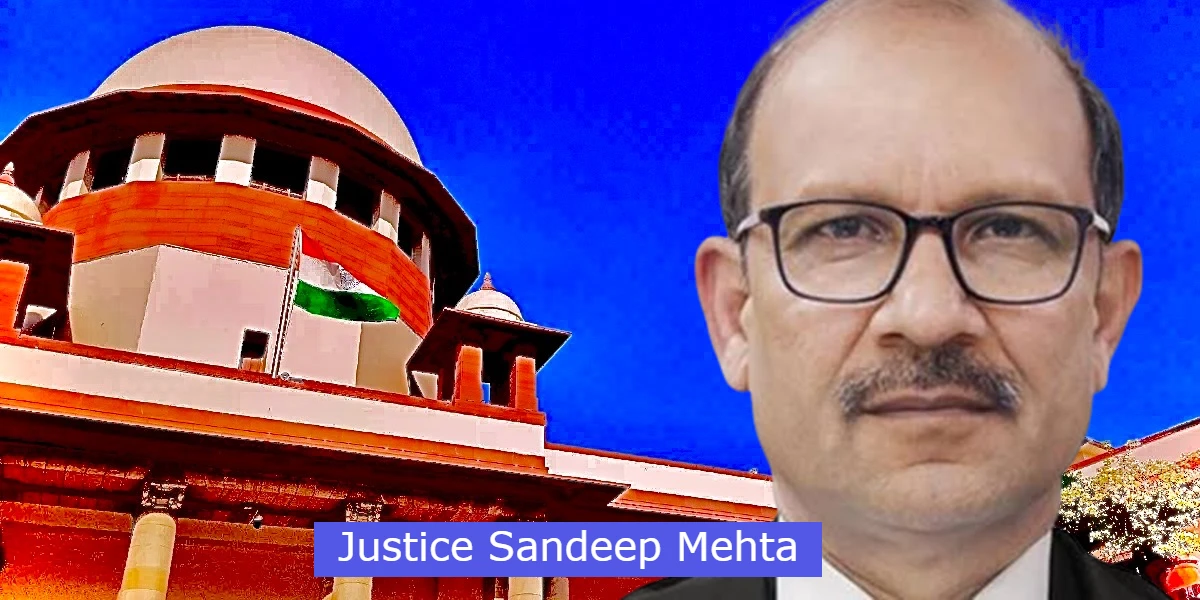
Justice Sandeep Mehta’s Supreme Court Verdict Compels Chandigarh Administration to Harmonize Heritage Conservation with Sustainable Development
Introduction
The Chandigarh Administration’s failure to construct a protective verandah in front of Court Room No. 1 of the Punjab and Haryana High Court, as well as its refusal to lay green paver blocks in the adjacent open parking area, were the subject of a public interest litigation that was heard by the Supreme Court of India on May 28, 2025.
The court’s decision was made in response to the public interest litigation. These appeals were brought about as a consequence of a series of High Court rulings that were handed down in Chandigarh.
These judgments instructed the government to construct a verandah that was comparable to the ones that were located in Court Rooms 2 to 9, and then to change the kutcha parking area into ecologically friendly green pavers with trees planted.
For any queries or to publish an article or post or advertisement on our platform, do call at +91 6377460764 or email us at contact@legalmaestros.com.
The Supreme Court bench consisting of Justice Vikram Nath and Justice Sandeep Mehta upheld these rulings, despite the fact that they acknowledged the need of preserving the site’s UNESCO World heritage categorization and combining sustainable development with cultural conservation.
Facts of the Case
In November of 2024, the Punjab and Haryana High Court issued a letter of mandate, which instructed the Chandigarh Administration to begin construction of its main courthouse two weeks before it was scheduled to be completed.
By following this method, it was assured that the plans had been sent to the Foundation Le Corbusier in Paris, and that the plan had been reviewed by the Chandigarh Heritage Conservation Committee. Following the failure of the Chief Engineer to begin construction, the High Court initiated contempt proceedings against him.
For any queries or to publish an article or post or advertisement on our platform, do call at +91 6377460764 or email us at contact@legalmaestros.com.
In addition, the High Court issued an order to the Administration, instructing them to plant at least two hundred trees and green paver blocks in the kutcha parking area next to the historic structure by the month of February 2025.
Before the Supreme Court, the Administration filed an appeal against these directions, arguing that they might result in the loss of World Heritage status in accordance with the regulations of UNESCO and that they would violate the green belt designation of the Chandigarh Master Plan.
For More Updates & Regular Notes Join Our Whats App Group (https://chat.whatsapp.com/DkucckgAEJbCtXwXr2yIt0) and Telegram Group ( https://t.me/legalmaestroeducators )
For any queries or to publish an article or post or advertisement on our platform, do call at +91 6377460764 or email us at contact@legalmaestros.com.
Jurisdiction and Constitutional Provisions
In accordance with the extraordinary jurisdiction that is granted by Article 136 of the Constitution, the Supreme Court was the one that heard the appeals. The High Court was granted the right to issue writs in instances involving matters of public interest by Article 226 of the Constitution, which was the source of the orders in the beginning.
In addition, the case invoked international obligations in accordance with the UNESCO World Heritage Convention and its Operational Guidelines. In particular, paragraph 172 of the convention mandates that states parties must notify the World Heritage Committee and seek advice prior to beginning significant restorations or new constructions that could compromise the Outstanding Universal Value of a protected site.
Within the framework of the Administration’s Master Plan for Chandigarh, 2031, the open parking area was designated as a green belt in accordance with the local regulations, with the purpose of regulating the permitted land use and making sure trees are preserved.
For any queries or to publish an article or post or advertisement on our platform, do call at +91 6377460764 or email us at contact@legalmaestros.com.
Fundamental Issues before the Court
There were two basic issues that were decided by the Supreme Court. The first question that needed to be answered was whether or not the mandamus issued by the High Court, which authorized the construction of a verandah in front of Court Room No. 1, would be considered an impermissible modification to the historic facade of the Capitol Complex, so putting the UNESCO designation at risk.
The second issue centered on the Master Plan’s mandate that green paver blocks be constructed in the kutcha parking lot that has been designated as a green belt. This is done in order to strike a balance between the demand for parking space for court officials, litigants, and lawyers and the need to maintain environmental sustainability.
Underlying these issues was the issue of institutional competence and the separation of powers: the Court was required to acknowledge expert legacy bodies while also fulfilling its commitment to offer fundamental practical conveniences for those who utilize the court.
For any queries or to publish an article or post or advertisement on our platform, do call at +91 6377460764 or email us at contact@legalmaestros.com.
Heritage Conservation and UNESCO Guidelines
It was the UNESCO Operational Guidelines that were at the center of the debate about the verandah. In accordance with paragraph 172, the World Heritage Committee must be informed in advance of any new development that is either irreversible or has the potential to compromise the site’s Outstanding Universal Value. Despite the fact that the Chandigarh Administration said that it had provided the Foundation Le Corbusier with ideas in theory, there was no evidence of any formal interaction with UNESCO.
The Supreme Court discovered, via the examination of archival correspondence from 1956, that the senior architect had suggested a verandah in front of the main courtroom; however, the Chief Justice at the time had rejected the idea in order to preserve the original architectural goal.
According to the guidelines, the Court made the observation that a projection constructed using modern lightweight and reversible materials, such as the verandahs that are now in place for Court Rooms 2 through 9, would not be considered a “major restoration.” Rather than being a modification that would be permanent, it was argued that the inclusion was more of a minimum protective step.
For any queries or to publish an article or post or advertisement on our platform, do call at +91 6377460764 or email us at contact@legalmaestros.com.
Sustainable Development and Green Belt Regulation
Regarding the green belt kutcha parking lot that is located inside the Capitol Complex, the second dispute took place. In its decision, the High Court proposed the installation of ecologically friendly green paver stones that would enable water to percolate through them and would also allow for tree planting in between them in order to protect vertical vegetation.
In accordance with the Administration’s position, any paving would constitute a violation of the Master Plan’s designation and would put the impending reforestation in jeopardy. In Rajeev Suri v. Delhi Development Authority, 2021, the Supreme Court reaffirmed, on the basis of previous judgments of this Court, that legitimate development and environmental preservation may coexist peacefully via the implementation of mitigating steps.
The Court came to the conclusion that green pavers that were sprinkled with tree seedlings would promote ecological balance, reduce dust pollution, and fulfill the severe parking demand of three to four thousand autos on a daily basis. This decision was made without compromising the integrity of the green belt.
For any queries or to publish an article or post or advertisement on our platform, do call at +91 6377460764 or email us at contact@legalmaestros.com.
Judgment and Directions
These rules were used by the Supreme Court in order to reject petitions that were submitted by the Chandigarh Administration. Both the rulings issued by the High Court on November 29 and December 13, 2024, which required the construction of verandahs, were upheld.
In addition to recommending that modern, detachable construction technologies be used, the Court strongly recommended that the Administration get ex-post facto clearance from UNESCO in the event that it was necessary to do so. In addition, it reaffirmed the decisions that were made on February 7 and February 21, 2025, regarding green paver blocks.
As a result, the administration of the High Court was compelled to collaborate with landscaping experts in order to ensure that adequate tree planting and supervision by a designated committee were carried out.
For any queries or to publish an article or post or advertisement on our platform, do call at +91 6377460764 or email us at contact@legalmaestros.com.
In order to provide the Administration the opportunity to implement the mandamus without fear of immediate punishment, the Court decided to defer the contempt proceedings for a period of twelve weeks. This allowed for compliance to take place under the circumstances.
Implications for Environmental and Heritage Jurisprudence
The decision has significant repercussions for the area. In the first place, it highlights the need of following local planning standards and international conservation principles in conjunction with court decisions in order to ensure that historic places have infrastructure that is in working condition.
Secondly, it demonstrates that the Court is willing to provide approval for reversible architectural improvements that are in accordance with the concept of Outstanding Universal Value and the functional necessity requirement.
For any queries or to publish an article or post or advertisement on our platform, do call at +91 6377460764 or email us at contact@legalmaestros.com.
Thirdly, the decision promotes environmentally responsible urban solutions that strike a balance between environmental concerns and practical requirements by providing support for green paver technologies. At long last, the Court’s calibration of contempt relief demonstrates its pragmatic purpose in monitoring compliance without resorting to severe punitive measures.
Conclusion
Within the context of the Chandigarh verandah and green paver issue, the Supreme Court’s decision strikes a careful balance between safeguarding a UNESCO World Heritage site and ensuring that the court’s stakeholders have access to the amenities they need.
Through the interpretation of Article 136 authority in accordance with international heritage standards and the Chandigarh Master Plan, the Court demonstrated that sustainable development and historic preservation do not necessarily have to be in conflict with one another.
For any queries or to publish an article or post or advertisement on our platform, do call at +91 6377460764 or email us at contact@legalmaestros.com.
The concept that contemporary practical demands may be satisfied while keeping Outstanding Universal Value was enhanced as a result of this. Professional advice and minimal adjustments that can be reversed were taken into consideration. As a result of this verdict, future management of protected locations will be directed, therefore demonstrating that, according to the Rule of Law, development and preservation may coexist.





![JOB POST: Junior Associate at ASM Law Chambers, Jaipur [Freshers]](https://legalmaestros.com/wp-content/uploads/2025/11/Gemini_Generated_Image_8wrxer8wrxer8wrx-768x708.png)

